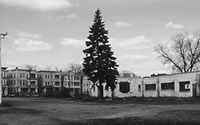Waste Site Cleanup & Reuse in New England
Went Field Restoration and Expansion Project
|
Success in EPA-Conducted Targeted Brownfields
Assessment , Assessment Demonstration Pilot Program and the Job
Training Pilot (JTP) Program.
Bridgeport, CT
(April 30, 2002)
Contacts
On May 1, 2002, the Park City Brownfields Redevelopment Partnership was awarded an EPA New England Environmental Merit Award for their work to restore and expand Went Field Park in the city of Bridgeport, CT. The partnership integrated funding and resources from the EPA Assessment Demonstration Pilot (ADP) Grant program, the EPA Job Training Pilot (JTP) program, an EPA-conducted Targeted Brownfields Assessment (TBA), and leveraged an additional $4 million in funding to achieve their goal of providing improved recreational facilities, open space, and educational opportunities to the residents of the West End neighborhood as well as to improve the overall image of Bridgeport.
The Park City Brownfields Redevelopment Partnership is an umbrella group for a number of the non-profit agencies, community groups, and government entities working to restore and expand Went Field Park, including Went Field Park Association, Groundworks Bridgeport, and Bridgeport Neighborhood Trust. The restoration is the largest community-based project in the city and one of the largest in the country. The $4.4 million project expanded the park from 6 to 10 acres by revitalizing two adjacent brownfields properties. Over $4 million was committed by municipal, state, and federal resources. Significant support also came from the West End community businesses and residents.
The expansion of Went Field Park required the city to assess, acquire, and cleanup two adjacent commercial sites. The Exmet site, a former metal extrusion company, had been vacant since 1989. Bridgeport used part of its $200,000 EPA ADP grant to fund environmental site assessments of the Exmet site from 1997 to 2000. EPA conducted a $75,000 TBA on the Swan Engraving site, a former printing company in 2000 with subsequent work at the site funded by the city's ADP grant. The assessments identified the presence of low-level solvents in groundwater. The contamination is being addressed in accordance with the Connecticut Department of Environmental Protection standards. As part of the applied study component of the JTP, local students of the environmental training program will be trained in groundwater monitoring and data management using the existing monitoring program at the site.
The Went Field Park, immediately adjacent to an Interstate 95 ramp, is a gateway to the 200-acre West End Industrial Area, which currently under redevelopment. Revitalizing resources like the park is essential to improving the overall image of Bridgeport. The park was the P.T. Barnum Circus' winter quarters for over 50 years. Horses, tigers, and other domestic and exotic animals were housed on the property in large stables. Elephants were trained here as well. Performers and trainers resided in the surrounding homes.
Today, seventy percent of the West End neighborhood of Bridgeport is minority and the median annual household income is $8,900. The nearby Elias Howe Elementary School is land-locked with no outdoor play areas. Bassick High School, located a few blocks away, is one of the only high schools in the state of Connecticut that lacks adjoining athletic facilities. The schools and the residents of the neighborhood will now be able to use the expanded and improved recreation facilities at the renovated park.
The city of Bridgeport was one of the first in the nation to use stakeholder involvement together with the redevelopment process to revitalize whole communities rather than parcels of land. Issues of crime, lack of funding, environmental stigma, and lack of neighborhood involvement were all overcome by meaningful involvement in decision-making. Participation took place in stakeholder meetings, design workshops, public safety meetings, and public gatherings. Stakeholders included residents of the neighborhood, city departments, state and federal agencies, neighborhood groups, neighborhood schools, Barnum Museum, Bridgeport Regional Business Council, West End businesses, Bridgeport Neighborhood Trust, and Latino Softball League.
| EPA Fact Sheet: | EPA Supplemental Assistance - Bridgeport, CT. |





